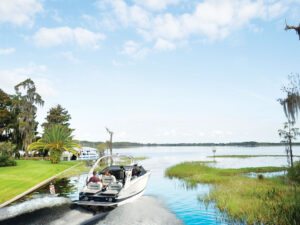
I can tie a bowline around my waist with one hand. Either hand, in fact. Which is why I’m drinking Chuck Larson’s beer right now. Chuck bet me the case of Rhinelander shorties he had on the seat of his truck that I could not perform this trick, in one try, with my left hand. Chuck forgot that I am left-handed. But no matter anyway because, thanks to the Boy Scouts, I’m an ambidextrous bowline tier.
I’ve been reminiscing about my Boy Scout experience ever since I completed the requirements for the Motorboating merit badge and have concluded that the most-enduring Scouting skill is knot tying. It has been exactly 40 years since I hung up my Troop 28 neckerchief, but I can still tie the six knots required for Scout advancement, and I use at least two of them — the square knot and the taut-line hitch — on a regular basis.
It was the taut-line hitch that helped me score Chuck’s beer. The sun finally came out while we were trolling in his Yar-Craft for walleye and so it seemed to me an appropriate time to deploy the sun top, but Chuck just muttered, “It’s broke.”
The adjustable nylon straps that secure the aft top bow to the gunwales were missing. Those straps hold the canvas taut (foreshadowing here), and without tautness, the top would just sort of sag over us. I cast my eyes around the boat and spotted the end of a fish-stringer cord protruding from inwale stowage. I used the cord and two Scout knots — two half-hitches on the bow end and a taut-line hitch on the gunwale end — to secure the sun top in a functioning fashion. The taut-line hitch is a slipknot that doesn’t slip when it’s under tension; its classic application is to tighten guy ropes on a tent. Once I had the fish-stringer cord nice and snug, it stayed that way.
This impressed Chuck. And over the years, my deployment of the taut-line hitch has impressed many people. It’s like a magic trick to those poor souls who only know how to make a wad of generic knotting when they need to tie down brush in the bed of a truck.
Eventually I told Chuck about the time I used a sheet bend to turn a water hose into an emergency anchor line, and how I learned to tie the bowline with one hand. The premise was that a Scout who has slipped off a cliff and landed on a precarious ledge could tie the bowline, which makes a loop that will not slip, around his waist and then be pulled to safety by his buddies from above. If that Scout could do this one-handed, he could tie the bowline even with a broken arm! To a 12-year-old boy, this was a fabulously dramatic scenario, and we practiced for hours perfecting the precise flip of the wrist required to tie the knot.
However, this is the only way I learned how to tie a bowline: around my waist with one hand. And if I want to tie one today — to make a loop on a line to toss over a piling, for example — I orient the line with the loop toward me and imagine I am making that knot with a broken arm. I’m practicing right now. Without setting down my beer.









